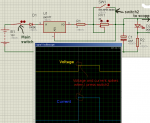Hi everyone.
For the new red burning laser I want to make , I would like (to optimize the life of the diode, and the autonomy of the laser) to make a custom driver that would allow the laser not to be alwaws at full power.
For example the driver will output 50mA most of the time, and when I press a switch, it goes to 300mA, the time to burn something (or for another reason) and when it's finished, I release the swith and it goes back to 50mA.
I tried to simulate a "modified" DDL driver ( I just added a switch ,see on the attached picture) on Proteus Isis ( a trial version) to see it it would work, but I have a problem. When I press the switch, there is a current "spike". I wondered if it was an issue with the simulation (we can only trust reality ^^ ), or if it will happen in a real circuit? I can't try because I have no oscilloscope, just a DMM.
On the picture I posted, the spike is not big but on another test I made, it was bigger (enough to kill a diode ?), and the problem is that I don't really know what changed between the two circuits and I would like my driver not to burn the diode, so I must be sure before I build it.
and I would like my driver not to burn the diode, so I must be sure before I build it.
The funny thing is that if I remove the capacitor from the circuit, the spike disapears, whereas I thought it was there to prevent such spikes :gun: .
Has someone ever tried such a circuit, or could confirm (or not) the simulation ? Does someone sell a cheap and safer driver that has the feature i'm looking for ?
Or do I need to build a different circuit ? (it must be as small as possible, but without SMD :evil: )
Thank you, and sorry for my english :thanks:
For the new red burning laser I want to make , I would like (to optimize the life of the diode, and the autonomy of the laser) to make a custom driver that would allow the laser not to be alwaws at full power.
For example the driver will output 50mA most of the time, and when I press a switch, it goes to 300mA, the time to burn something (or for another reason) and when it's finished, I release the swith and it goes back to 50mA.
I tried to simulate a "modified" DDL driver ( I just added a switch ,see on the attached picture) on Proteus Isis ( a trial version) to see it it would work, but I have a problem. When I press the switch, there is a current "spike". I wondered if it was an issue with the simulation (we can only trust reality ^^ ), or if it will happen in a real circuit? I can't try because I have no oscilloscope, just a DMM.
On the picture I posted, the spike is not big but on another test I made, it was bigger (enough to kill a diode ?), and the problem is that I don't really know what changed between the two circuits
The funny thing is that if I remove the capacitor from the circuit, the spike disapears, whereas I thought it was there to prevent such spikes :gun: .
Has someone ever tried such a circuit, or could confirm (or not) the simulation ? Does someone sell a cheap and safer driver that has the feature i'm looking for ?
Or do I need to build a different circuit ? (it must be as small as possible, but without SMD :evil: )
Thank you, and sorry for my english :thanks:







